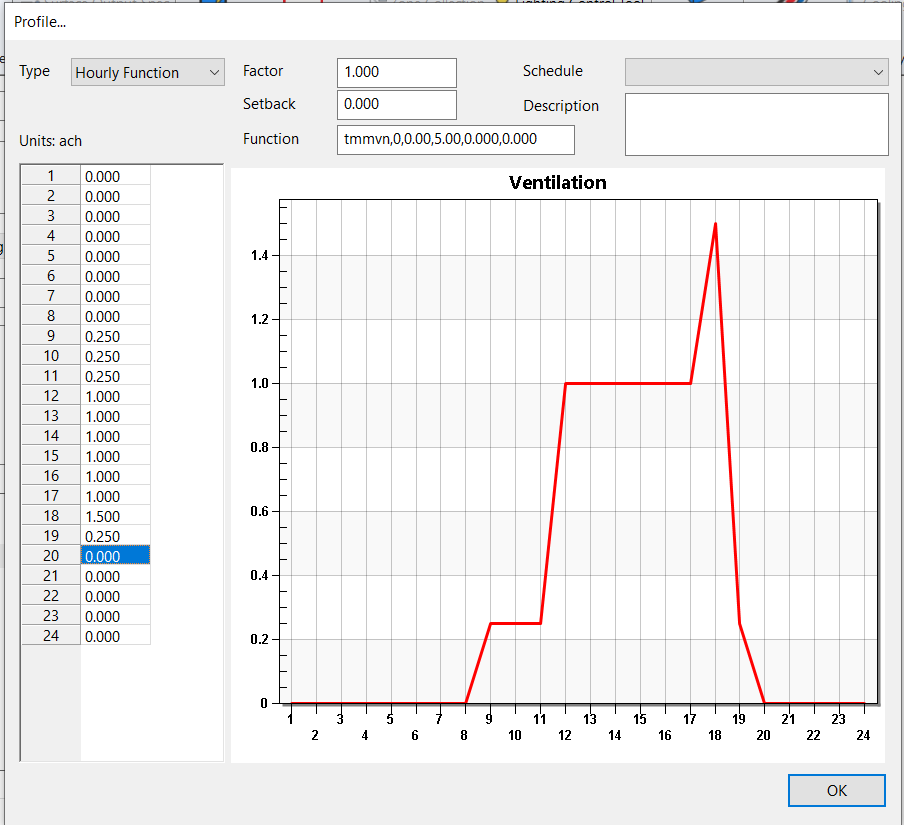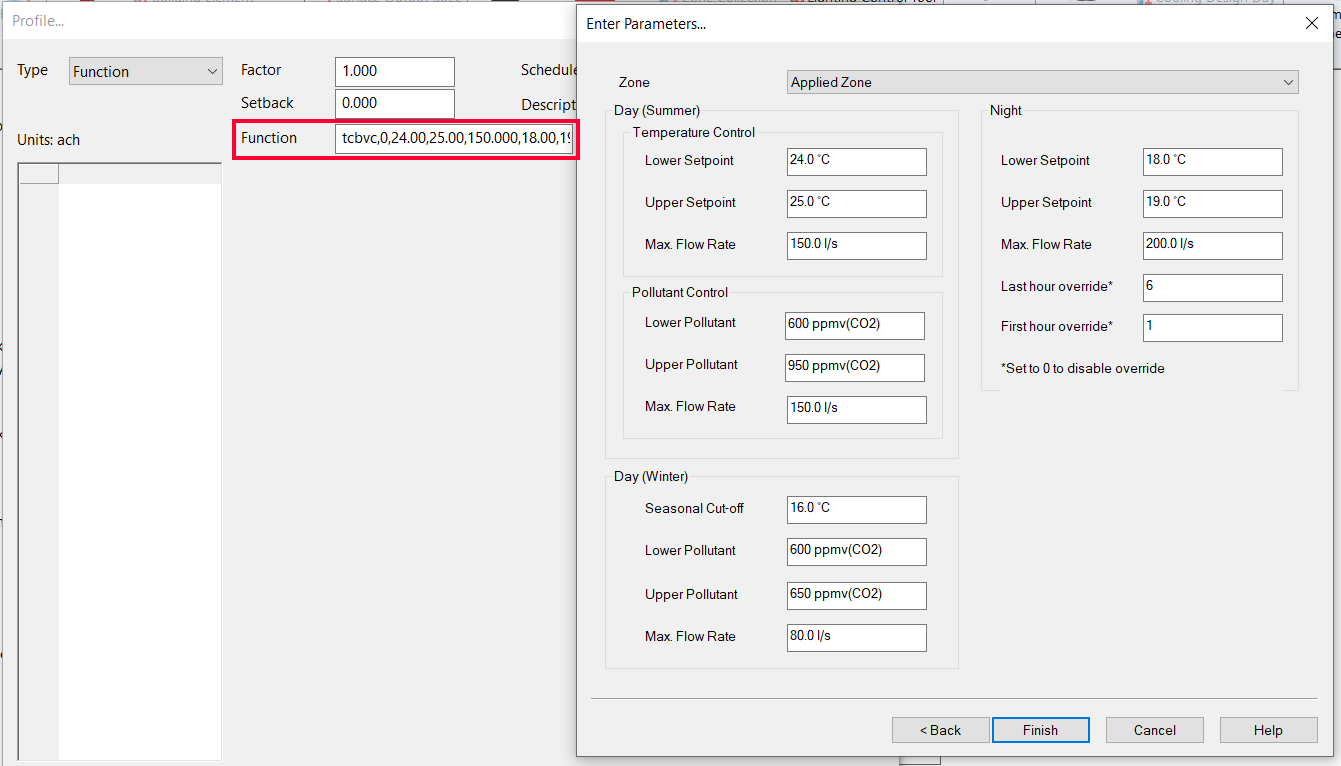Ventilation Functions¶
Ventilation control functions allow you to control the amount of mechanical ventilation based on factors such as:
Zone dry bulb temperature
External Temperature
Zone pollutant level
As ventilation functions often combine multiple rules simultaneously, (e.g. external temperature control & dry bulb control), it is useful to remember that the final ventilation rule is usually the product of all of the other signals.
For example, if an internal dry bulb temperature rule results in a 75% ventilation rate but an external temperature rule produces a signal of 0, the effect will be that there will be no ventilation as a signal of 0 from any of the rules always suppresses the other rules.
For a function to produce the maximum ventilation rate, all constituent signals must be 1.
Note
The function tcbvc is a special case, and is used to model hybrid mechanical ventilation units.
Hourly/Yearly Functions¶
Each function can be modified either on an 24 hourly basis or on a 8760 hour yearly basis. This is essentially a way of further controlling when the ventilation functions will operate.

Above is an example of a complex hourly profile, which can be combined in conjunction with a schedule to modify the output of a function for each hour. These values can be thought of as multipliers to output of the function.
tcmvc¶
This function is intended for a mechanical ventilation system where the ventilation is controlled from a single zone’s dry bulb temperature.

The ventilation starts when the temperature in the zone reaches the lower limit and increases proportionally until the upper limit is reached and the maximum ventilation value will apply.
The ventilation rate starts to reduce when the inside and outside temperatures are equal and will be completely off when the outside temperature is one full degree above the inside.
Zone - The zone whose dry bulb temperature will be used to control the ventilation.
Lower Limit - The ventilation will be off if the dry bulb temperature of the controlling zones is below this value.
Upper Limit -The ventilation will be maximum when the dry bulb temperature of the controlling zone is above this value.
Maximum Vent. Value - The maximum amount of ventilation the function can provide, measured in air changes per hour (ACH).
tcmvn¶
This function is intended for a mechanical ventilation system where the ventilation is controlled from a single zone’s dry bulb temperature.

The ventilation starts when the temperature in the zone reaches the lower limit and increases proportionally until the upper limit is reached and the maximum ventilation value will apply.
Zone - The dry bulb temperature of this zone will be used to control the ventilation function.
Lower Limit - The ventilation will be off when the dry bulb temperature of the zone is below this value.
Upper Limit -The ventilation will be maximum when the dry bulb temperature of the controlling zone is above this value.
Maximum Vent. Value - The maximum amount of ventilation the function can provide, measured in air changes per hour (ACH).
tmmvc¶
This function is intended for a mechanical ventilation system with a minimum ventilation rate expressed in \(l/s/m^2\) which will be supplemented by additional ventilation that will be controlled from a single zone’s dry bulb temperature.

The minimum ventilation rate will be specified in \(l/s/m^2\).
The additional ventilation will start when the temperature in the zone reaches the lower limit and increases proportionally until the upper limit is reached and the additional ventilation value plus the minimum value will apply.
The additional ventilation rate will start to reduce when the inside and outside temperatures are equal and will be completely off when the outside temperature is one full degree above the inside.
Zone - The dry bulb temperature of this zone will be used to control the ventilation function.
Lower Limit - The additional ventilation will be off when the dry bulb temperature of the zone is below this value - the ventilation rate will be at the minimum vent rate.
Upper Limit - The additional ventilation will be maximal when the dry bulb temperature of the controlling zone is above this value. The ventilation rate will be the min vent rate + additional vent rate above this temperature.
Minimum Vent. Value - The minimum amount of ventilation the function can provide for any hour, measured in \(l/s/m^2\).
Addition Vent Value - The maximum additional ventilation used at any hour when the function is operational. Measured in air changes per hour (ACH).
tmmvn¶
This function is intended for a mechanical ventilation system with a minimum ventilation rate expressed in \(l/s/m^2\) which will be supplemented by additional ventilation that will be controlled from a single zone’s dry bulb temperature.

The minimum ventilation rate will be specified in \(l/s/m^2\).
The additional ventilation will start when the temperature in the zone reaches the lower limit and increases proportionally until the upper limit is reached and the additional ventilation value plus the minimum value will apply.
Zone - The dry bulb temperature of this zone will be used to control the ventilation function.
Lower Limit - The additional ventilation will be off when the dry bulb temperature of the zone is below this value - the ventilation rate will be at the minimum vent rate.
Upper Limit - The additional ventilation will be maximal when the dry bulb temperature of the controlling zone is above this value. The ventilation rate will be the min vent rate + additional vent rate above this temperature.
Minimum Vent. Value - The minimum amount of ventilation the function can provide for any hour, measured in \(l/s/m^2\).
Addition Vent Value - The maximum additional ventilation used at any hour when the function is operational. Measured in air changes per hour (ACH).
tcbvc¶
This function can be used to model hybrid mechanical ventilation systems, and it has two modes of operation; day mode and night mode.
The function is in day mode when the applied schedule is 1, and is in night mode when the applied schedule is 0.
The function also has two seasonal modes of operation; summer mode and winter mode.

Summer Mode¶
The function is in summer mode when the external temperature is at or above the seasonal cut-off temperature.
In summer mode, flow is controlled based upon zone dry bulb temperature and pollutant level.
Flow rates will be linearly interpolated as necessary using the set-points for temperature and pollutant and the higher of these calculated flow rates will be used.
Winter Mode¶
The function is in winter mode when the external temperature is below the seasonal cut-off temperature.
In this mode, flow is controlled based on the zone pollutant level. The flow rate will be linearly interpolated up to the maximum flow rate using the set-point for pollutant.
Night Mode¶
Night mode occurs when the applied schedule is 0. If override times are used, night operation will not take place during hours after the last hour override and before the first hour override.
In this mode, the ventilation will be based upon zone dry bulb temperature. The flow rate will be linearly interpolated up to the maximum flow rate using the set-point for temperature.